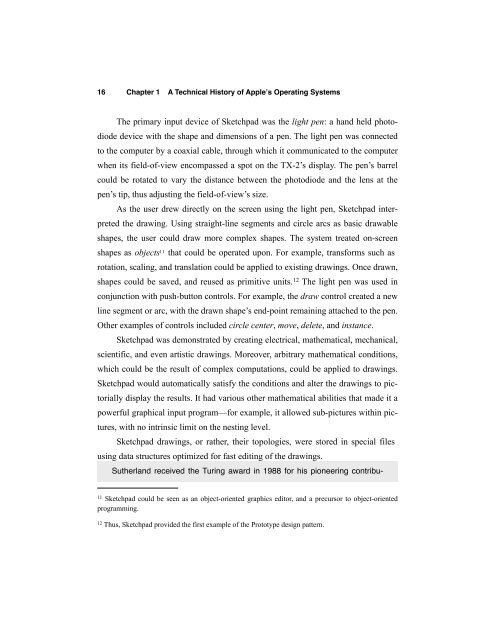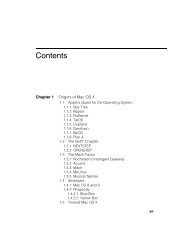A Technical History of Apple's Operating Systems - Mac OS X Internals
A Technical History of Apple's Operating Systems - Mac OS X Internals
A Technical History of Apple's Operating Systems - Mac OS X Internals
You also want an ePaper? Increase the reach of your titles
YUMPU automatically turns print PDFs into web optimized ePapers that Google loves.
16 Chapter 1 A <strong>Technical</strong> <strong>History</strong> <strong>of</strong> Apple’s <strong>Operating</strong> <strong>Systems</strong><br />
The primary input device <strong>of</strong> Sketchpad was the light pen: a hand held photo-<br />
diode device with the shape and dimensions <strong>of</strong> a pen. The light pen was connected<br />
to the computer by a coaxial cable, through which it communicated to the computer<br />
when its field-<strong>of</strong>-view encompassed a spot on the TX-2’s display. The pen’s barrel<br />
could be rotated to vary the distance between the photodiode and the lens at the<br />
pen’s tip, thus adjusting the field-<strong>of</strong>-view’s size.<br />
As the user drew directly on the screen using the light pen, Sketchpad inter-<br />
preted the drawing. Using straight-line segments and circle arcs as basic drawable<br />
shapes, the user could draw more complex shapes. The system treated on-screen<br />
shapes as objects 11 that could be operated upon. For example, transforms such as<br />
rotation, scaling, and translation could be applied to existing drawings. Once drawn,<br />
shapes could be saved, and reused as primitive units. 12 The light pen was used in<br />
conjunction with push-button controls. For example, the draw control created a new<br />
line segment or arc, with the drawn shape’s end-point remaining attached to the pen.<br />
Other examples <strong>of</strong> controls included circle center, move, delete, and instance.<br />
Sketchpad was demonstrated by creating electrical, mathematical, mechanical,<br />
scientific, and even artistic drawings. Moreover, arbitrary mathematical conditions,<br />
which could be the result <strong>of</strong> complex computations, could be applied to drawings.<br />
Sketchpad would automatically satisfy the conditions and alter the drawings to pic-<br />
torially display the results. It had various other mathematical abilities that made it a<br />
powerful graphical input program—for example, it allowed sub-pictures within pic-<br />
tures, with no intrinsic limit on the nesting level.<br />
Sketchpad drawings, or rather, their topologies, were stored in special files<br />
using data structures optimized for fast editing <strong>of</strong> the drawings.<br />
Sutherland received the Turing award in 1988 for his pioneering contribu-<br />
11 Sketchpad could be seen as an object-oriented graphics editor, and a precursor to object-oriented<br />
programming.<br />
12 Thus, Sketchpad provided the first example <strong>of</strong> the Prototype design pattern.




